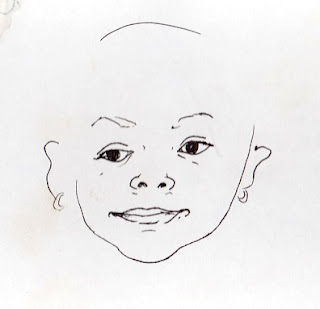
Here is a wonderful facet of America, and especially the DC area: the wealth of international recipes and culinary traditions that have floated to our shores along with our poor, tired, and hungry huddled masses.
These illustrations were inspired by the international vegetarian food fair put on by the members of the Capitol Memorial Church in DC. The members hail from all over the world, and so they hold an annual food fair for the community, where everyone can come and sample as much as they can eat. This year they are also putting out a much-anticipated cookbook.
Each drawing loosely illustrates one of five rather wide geographical regions represented.
First, Latin America, and where would we be without tortillas and tamales and cherimoyas and flan?

The Caribbean is another near neighbor, so it makes sense that Caribbean food would influence our diet. As the crossroads of the world, Caribbean traditions have also been impacted in turn by African, Indian, Spanish and American influences, to name a few. But when I drew this, I was mostly thinking about islands, music, and pina coladas.

Europe and North America were lumped together into a single region, so I envisioned European immigrants meeting in the great melting pot of New York to share a food that has probably been called both European and American: Pizza.
A lot of American food, especially in rural areas, hails from Europe. I used to work in a retirement home in rural Pennsylvania where most of the residents claimed German/Ukranian/Hungarian heritage. There the four main food groups were potatoes, tomatoes, meat, and sauerkraut.

Asia includes a number of different countries and cultures, but I just focused on India and South Korea in this drawing, attempting to describe South Korea in careful and aesthetic rectangles, and India in overflowing circles of all sizes.
I love Indian food. I want some right now.

Africa is another wide region. But I focused on the part of Africa I am familiar with, West Africa, and especially West African street food. Here a student is buying red-red (fried plantains with red beans). Red-red exemplifies what I love about African street food. There are the basic ingredients, plantains and beans, and then all of these other little things you can add, or not, depending on your taste: palm oil, hot pepper, and garri (dried, grated cassava), at no extra charge.
Now I'm really really hungry.
All illustrations are in markers on white paper
(Faber-Castell pens, actually. I am a huge, huge fan of these for drawing)
 There was also a request to move North America out of the urban landscape and into the heartland. I kept basically the same people and their arrangement, but changed the background and the type of food on the table. Better or worse?
There was also a request to move North America out of the urban landscape and into the heartland. I kept basically the same people and their arrangement, but changed the background and the type of food on the table. Better or worse?















































